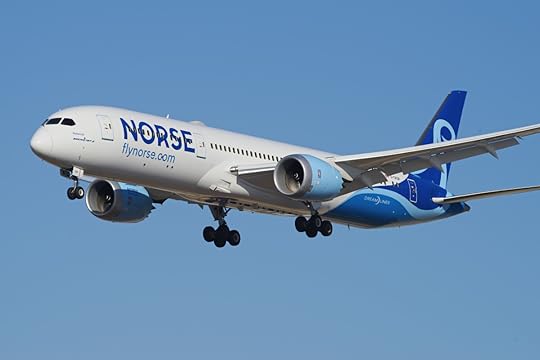Cheapest Way to Fly to Europe is Coming to an End
The first time I ever traveled to Europe was following my junior year of college, when I went along with my roommate to visit a high school friend who lived in France. Understandably, we did not have much disposable income at the time, but we found a flight that was miraculously inexpensive and pulled off a trip I'll never forget.
Years later, I continue to fly on a similar budget airline with my wife whenever we travel to Europe, though we now spring for premium class tickets, which are still around half the price of a Delta economy fare.
Unfortunately, it sounds like I will have to find a new way to travel, as my beloved budget airline is ending a significant number of its flights from the United States to Europe.
Norse Atlantic: Ideal for Cheap Europe TravelMy first time traveling to Europe came in 2017, when I flew from New York to Paris to kick off a couple of weeks backpacking and camping through France and Italy.
We were college students relying on part-time jobs to pay for our trip, so we needed the fare to be as cheap as possible. I don't remember exactly what we paid for our tickets or even which airline we flew. However, I do know that the only airline currently offering fares even close to what we paid is Norse Atlantic Airways.
At the time of publishing, the cheapest round-trip, nonstop flight from New York to Paris departing early next month is just over $500 from American Airlines and United Airlines, and $648 from Delta. At Norse, the fare is $278.
Candidly, Norse is decidedly a budget airline, and it feels like a budget airline – especially when you're flying economy. But when you're just looking to get from the United States to Europe in the cheapest way possible, it does its job.
 Norse Atlantic Airways Boeing 787 with registration G-CKOF shown approaching LAX, Los Angeles International Airport, for landing.
Norse Atlantic Airways Boeing 787 with registration G-CKOF shown approaching LAX, Los Angeles International Airport, for landing. My favorite travel hack as an adult with a slightly larger disposable income, however, has been Norse's premium cabin.
While it certainly does not compare to the first-class options offered by the legacy airlines on long-haul flights and does feel a bit dated, the Norse premium cabin does include extra-wide full-recline seats (though not lay-flat), along with two meal services, complimentary soft drinks and alcoholic beverages, pillows and blankets, and priority check-in.
Norse's premium cabin does not compare to the first-class or even business class of most other airlines, but it is absolutely better than the economy or basic class of any other airline, and it's also significantly cheaper.
At the time of publishing, I can get a Norse premium fare round-trip, nonstop flight from New York to Paris departing early next month for $509 – less expensive than the cheapest fare offered by most airlines. This is only amplified during peak season, when Norse's premium fares are often around half the price of an economy ticket on other airlines, as was the case this summer when I flew from New York to Rome on Norse.
Norse Cuts Half of Its U.S. to Europe RoutesUnfortunately, it sounds like my favorite way to travel from New York to Paris is coming to an end.
According to data from aviation analytics firm Cirium, Norse Atlantic Airways is cutting half of its routes from the United States to Europe, including its only two flights to Paris Charles de Gaulle.
Here are all six of the flights Norse will be cutting beginning in October:
Los Angeles to Athens, GreeceMiami to LondonNew York to BerlinNew York to Oslo, NorwayNew York to ParisLos Angeles to ParisFor now, Norse will continue to operate its other six routes between the United States and Europe:
New York to LondonNew York to RomeNew York to AthensOrlando to LondonLos Angeles to LondonLos Angeles to RomeWhile these flights will continue to operate for now, the recent cuts could be a sign that more changes could be on the horizon.
Uncertain FutureThis unfortunate announcement comes just a few days after the airline announced that it operated at a world-best 97% load factor in the second quarter, meaning simply that it filled 97% of its seats over that period.
While this is remarkable and almost totally unmatched by the rest of the industry, where load factors are typically between 70% and 90% worldwide, the bad news is that Norse still didn't turn a profit, losing about $6 million in the second quarter.
As a budget airline, Norse doesn't necessarily make its money on fares. Instead, it relies on upgrades and add-ons. In its most recent filings, the airline reported that 20% of its revenue per passenger came from additional fees outside of the fare.
"High loads do not equal profitability," travel expert Dillon Shah of Simple Flying wrote this week. "Loads are often used as a metric of success for a given route. High loads mean the airline has been able to fill its seats. But at what cost?"
If Norse is leading the world in load factor by a wide margin and is still losing money, that's not a great sign for its long-term future – at least in its current model. Logically, Norse is going to have to make some changes if it is going to survive in the long run.
Maybe these changes will include increased fares or additional fees, or perhaps they will include more route cuts. Either way, it's becoming clear to me that the cheapest way to travel from the United States to Europe is coming to an end.
Men's Journal's Blog
- Men's Journal's profile
- 1 follower



